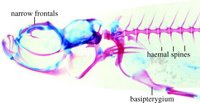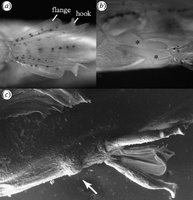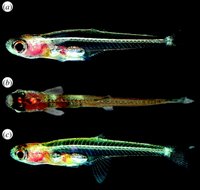Paedocypris, a new genus of Southeast Asian cyprinid fish with a remarkable sexual dimorphism, comprises the world's smallest vertebrate
Maurice Kottelat1, 2, *, Ralf Britz3, Tan Heok Hui1 & Kai-Erik Witte4
1Raffles Museum of Biodiversity Research, Department of Biological Sciences, National University of Singapore, Lower Kent Ridge Road, Singapore 119260, Singapore
2Route de la Baroche 12, Case Postale 57, 2952 Cornol, Switzerland
3Department of Zoology, The Natural History Museum, Cromwell Road, London SW7 5BD, UK 4Max Planck Institute for Developmental Biology, Spemannstrasse 35/3, 72076 Tübingen, Germany, *Author for correspondence mkottelat@dplanet.ch, Received 20 October 2005; Accepted 21 November 2005.
 |  |  |  |
Figure 3(a) Paedocypris micromegethes, paratype male, ZRC 49869, 10.4mm; pelvic fins, anteroventral view, showing hook and flange on anterior ray. (b) Paedocypris micromegethes, paratype, male, BMNH 2004.11.16.1-40, 10.9mm, ventrolateral view on hypertrophied pelvic arrector and abductor muscles marked by asterisk symbols. (c) Paedocypris progenetica, paratype male, ZRC 43199, 8.5mm, scanning electronic micrograph of pelvic region in ventrolateral view, arrow points to keratinized prepelvic knob.
Figure 2(a) Paedocypris progenetica holotype male, MZB 5998, 8.6mm; arrow points to keratinized abdominal knob; (b) Paedocypris progenetica paratype female, ZRC 43199, 8.0mm; arrow points to preanal larval-fin-fold; (c) Paedocypris micromegethes holotype male, ZRC 49869, 10.4mm; arrow points to genital papilla; (d) paratype female, BMNH 2004.11.16.1-40, 10.0mm.
Figure 1 Living Paedocypris progenetica, CMK 18496, (a, b) male, ca 9mm; (c) female, ca 8.8mm.
Proceedings of The Royal Society B, ISSN: 0962-8452 (Paper) 1471-2954 (Online), Issue: FirstCite Early Online Publishing, DOI: 10.1098/rspb.2005.3419, Download PDF
Abstract - Paedocypris is a new genus of paedomorphic cyprinid fish from highly acidic blackwater peat swamps in Southeast Asia. It includes two new species, one of which (Paedocypris progenetica) appears to be the smallest fish and vertebrate known, with the smallest mature female measuring a mere 7.9mm. Paedocypris has many 'larval' features typically associated with paedomorphic fish (e.g. narrow frontals that leave the brain unprotected dorsally by bone and a precaudal larval-fin-fold), but, uniquely among fishes, males also possess highly modified pelvic fins with hypertrophied muscles and a keratinized pad in front of the pelvic girdle, which, we hypothesize, function together as a clasping or holding device, thereby suggesting an unusual reproductive mode. Unfortunately, habitat destruction jeopardizes the survival of these fishes and thus opportunities for further research.
Keywords: Paedocypris; Cyprinidae; peat swamps; smallest vertebrate; sexual dimorphism
1. Introduction - Miniaturization is an evolutionary phenomenon observed in all vertebrate lineages, but it is more frequently encountered in fishes. Fish species maturing at sizes under 20mm have been termed 'miniature fishes' by Weitzman & Vari (1988), who observed that miniaturization is commonly accompanied by a reduction of the laterosensory canal system of the head and body and reductions in the number of fin rays and body scales. Often, it is also combined with a poorly ossified, largely cartilaginous skeleton or a complete loss of bones (Johnson & Brothers 1993; Britz & Kottelat 2003).
We here describe two new species representing a new genus of miniature fishes (Paedocypris) from Southeast Asian peat swamp forests. In contrast to the general trend to simplification observed in miniature fishes, Paedocypris has evolved complex structural novelties in the pelvic girdle. Further, one of the new species, Paedocypris progenetica (figure 1), is the smallest recorded vertebrate, with a fully mature female measuring just 7.9mm.
Notes on habitat, food and reproductive biology
The habitat of both Paedocypris species is slow-flowing blackwater streams or pools in peat swamp forests, where they inhabit the deeper, cooler water layers, in the lower half of the water column close to the bottom (but not on the bottom). The two species were observed only in shaded areas, in primary or secondary forest, and were absent from light-exposed open areas.
Gut dissections indicate that Paedocypris feeds mainly on planktonic rotifers and cladocerans (60-500m).
The smallest female with ripe eggs measured 7.9mm in P. progenetica and 8.8mm in P. micromegethes. In a 9.1mm female P. progenetica, the ovaries contained four opaque eggs (diameter 0.3mm) and 53 transparent eggs (diameter less than 0.15mm). A 10.3mm female of P. micromegethes had ovaries with 21 opaque eggs (diameter 0.40-0.45mm (n=5), 0.30-0.40mm (n=16)) and about 30 transparent eggs (0.10-0.20mm diameter). There were no clear-cut size classes in eggs larger than 0.30mm, with all smaller ones of similar sizes. The two ovaries were simultaneously functional. The presence of only few fully developed eggs in the ovaries of both species indicates that eggs are most probably deposited individually.
The smallest male in which modified pelvic fins were unambiguously observed measures 8.2mm in P. progenetica (largest male 9.6mm) and 9.1mm in P. micromegethes (largest male 11.6mm). In P. progenetica, the prepelvic pad appears as a small knob (ca 0.3mm diameter), sometimes with a small groove and fold behind; the space between knob and pelvic-fin base is about equal to the egg size. In some specimens of P. micromegethes, the pad is slightly concave and pieces of unidentifiable tissue are attached.
Discussion, (a) Miniature fishes; Miniature fishes have been defined by Weitzman amd Vari (1988) as those species reaching sexual maturity at a size of under 20mm or, when maturity data are not available, not exceeding 26mm in the wild. A number of fish species discovered over the past few years have maximal known sizes ranging from 8.0 to 15.0mm (Kottelat and Vidthayanon 1993; Britz 2003; Watson and Walker 2004). An Australian marine gobioid fish, Schindleria brevipinguis (family Schindleriidae), was recently presented as 'almost certainly' the world's smallest vertebrate maturing 'by 7mm', at '7-8mm' or '6.5-7mm' on different pages in the paper (Watson and Walker 2004). Of the six known specimens, however, sexual maturity was objectively established only for the single female measuring 8.4mm. Maturity of the smaller males seems to have been inferred from the presence of the genital papilla as specimens were not dissected. Without histological examination, sexual maturity can be objectively established only by the presence of ripe eggs in the female's ovaries. That means, however, that Trimmatom nanus, another marine gobioid (Gobiidae), which has 'fully developed eggs...present from a standard length of 8mm and greater' (largest known individual 10.2mm) (Winterbottom amd Emery 1981), is the smallest previously recorded vertebrate.
Fishes are also the smallest known freshwater vertebrates, the current record being held by the Burmese cyprinid Danionella translucida (12.0mm, size at maturity unknown), followed by the Southeast Asian cobitid Kottelatlimia katik (mature at 13.0mm) and cyprinid Boraras micros (13.3mm, size at maturity unknown) (Kottelat and Lim 1992; Kottelat and Vidthayanon 1993) and the South American characid Xenurobrycon polyancistrus (13.1mm) (Weitzman and Vari 1988).
The discovery of P. progenetica, with a mature female of just 7.9mm and a maximum size of 10.3mm, makes it the smallest recorded vertebrate species, slightly smaller than the marine goby T. nanus. Paedocypris micromegethes, the females of which mature at 8.8mm (maximum 11.6mm), comes a close second as the smallest freshwater vertebrate.
The 7.9mm mature female of P. progenetica is not an unusually small individual. The 1mm mesh size that we use in peat swamps only rarely catches specimens smaller than 7mm and, therefore, introduces a size bias in our samples. Our largest sample contains 56 females (MZB5998, 5999, ZRC 43199), including the 7.9mm one and the individuals unambiguously identifiable as females are 5.9-8.3mm. The largest female is only slightly larger than the smallest mature one.
Typical features of miniature fishes include a tendency to simplify the skeleton and other structures, the production of very few, comparatively large eggs and (in freshwater species) a preference for standing or slow-flowing waters, often in nutrient-poor habitats (Weitzman amd Vari 1988). A number of miniature fishes are paedomorphic and show a truncated development, but accelerated maturation leading to dwarfed adults with larval features (progenetic paedomorphosis).
The conspicuous skin fold along the lower edge of the caudal peduncle of Paedocypris is observed in many fish larvae (Moser et al. 1984), but is normally lost early in ontogeny. Paedocypris is the only known cypriniform fish to retain it as an adult. The long caudal peduncle, the translucent body and the brain not protected by frontals are additional progenetic attributes
Most progenetic fishes tend to lose bones and scales, and to evolve bones that are very thin or perforated and part of the skeleton not ossifying but remaining cartilaginous (Johnson and Brothers 1993; Kottelat amd Lim 1994; Britz and Kottelat 2003). Paedocypris lacks scales and numerous bones and cartilages in the neurocranium (parietals, nasals, vomer, preethmoid, most circumorbitals), lower jaw (angular), hyopalatine arch (ectopterygoid), shoulder girdle (post-temporal) and axial skeleton (supraneural 2, epural); its reduced bones include the very narrow frontals. None of the basi-, cerato-, epi- or pharyngobranchials are ossified, except ceratobranchials 4 and 5. The number of branched dorsal rays is reduced to five (versus at least seven in most Cypriniformes), with that of the branched caudal rays to 14 (versus 17 in most Cyprinidae).
Sharply contradicting this general tendency of miniature fishes to simplification, Paedocypris possesses one feature that is unique among fishes--a complex pelvic girdle, in which the first pelvic-fin ray and its abductor muscles are hypertrophied and highly modified (figures 2-4). These modifications are present only in males and most probably play a role in reproduction.
The structure of the pelvic fin suggests that it forms a clasping device in conjunction with the prepelvic keratinized pad. It might be used to grab the female during mating, analogous to what is observed in the unrelated priapus fishes (family Phallostethidae) that use a modified pelvic girdle to hold the female in position during copulation (Villadolid and Manacop 1934) and transfer sperm to fertilize the eggs internally (Grier and Parenti 1994). Alternatively, the male Paedocypris might use its modified pelvic girdle and fin to keep position at a spawning site or to manipulate spawned eggs, which are almost certainly laid individually. The hypertrophied male genital papilla is most likely part of this functional complex. All these modifications, taken together, point to an unusual reproductive mode. The iridescent spot on top of the head of the male probably plays a role in female/male recognition or male display. The Royal Society - Article FULL HTML TEXT
more at Southeast Asian or biological and biology or Paedocypris and cyprinid or sexual dimorphism or Science and National Parks or animal diversity and fish
Related: Keyword biology, Tuesday, January 04, 2005 The Cassini-Huygens mission to Saturn, Sunday, March 20, 2005 Agriculture Secretary Mike Johanns, bovine spongiform encephalopathy (BSE), Thursday, March 24, 2005 Fish Oil Holds Promise in Alzheimer's Fight, Sunday, April 10, 2005 National Human Genome Research Institute (NHGRI), Friday, April 15, 2005 Study uncovers bacteria's worst enemy, Sunday, May 01, 2005 Yes, it is an exoplanet 2M1207 system, Friday, May 20, 2005 a polysaccharide called hyaluronan, Tuesday, May 24, 2005 pseudoneglect phenomenon, Friday, June 03, 2005 DOE JGI sequences DNA from extinct cave bear, Monday, June 06, 2005 From a Few Wild Ancestors, a Citrus Cornucopia, Tuesday, June 07, 2005 NHGRI Selects 13 More Organisms for Genome Sequencing, Sunday, July 24, 2005 Prehistoric Native Americans maize cultivation, Sunday, July 31, 2005 Protein 97 Synapse-associated (SAP97), Sunday, August 07, 2005 universal flu vaccine, Sunday, August 07, 2005 Smoking gun for Alzheimer's disease, Sunday, August 07, 2005 placental tissue, embryonic stem cells, Sunday, August 21, 2005 female senior faculty are still rare, Sunday, September 18, 2005 more rain would benefit New Orleans, Sunday, October 02, 2005 Rapid evolution of the quagga, Sunday, October 30, 2005 , Sunday, November 27, 2005 Give thanks for the cranberry, say dental researchers, Sunday, December 04, 2005 Poison + water = hydrogen, Sunday, December 11, 2005 40,000-year-old human footprints, Sunday, December 18, 2005 warfare in the Mesopotamian world, Sunday, December 18, 2005 Conditions for slavery, Sunday, December 25, 2005 Why Christmas trees are not extinct, Sunday, January 01, 2006 prostaglandins choreograph perturbations, Sunday, January 01, 2006 Cultural differences may explain variations in home remedy use, Sunday, January 08, 2006 Risky Sexual Behaviors in Miami, and Racial Influences on Children’s Care, Sunday, January 22, 2006 Twenty-seven previously unknown species discovered,











No comments:
Post a Comment